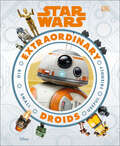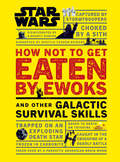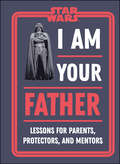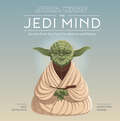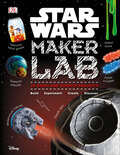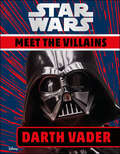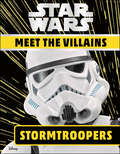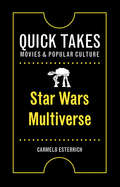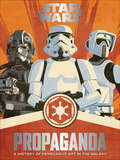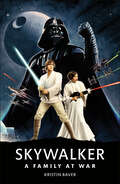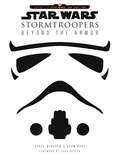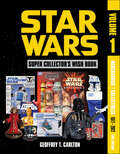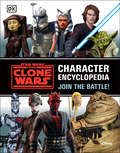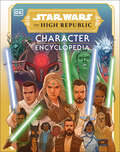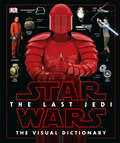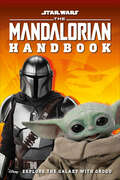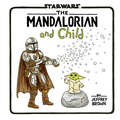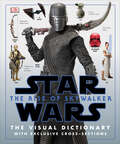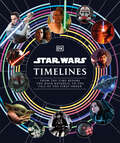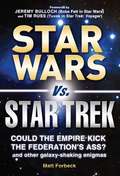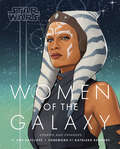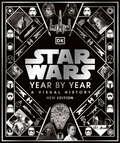- Table View
- List View
Star Wars Extraordinary Droids
by Simon BeecroftFind the droids you know and love and discover new favorites along the way.This Star Wars guide with a twist showcases a world of droids in close-up detail. Arranged from smallest to biggest, more than 50 droids of the galaxy are revealed with stunning photography and gorgeous artwork. The evocative descriptions will delight children and let them discover amazing droid facts, such as what tools R2-D2 uses and why GNK droids make a "gonk gonk" noise! Each page features fun droid facts and detailed close-up photographs for children to pore over, including firm favorites such as C-3PO and BB-8 as well as more unusual ones such as Professor Huyang, police droids, tiny probe droids, and new The Rise of Skywalker droid D-O.Star Wars Extraordinary Droids is a perfect gift for children who can't get enough of a galaxy far, far away. The book covers droids small (quiet, little mouse droids) and big (vulture droid starfighters), kind (memoir-writing PZ-4CO) and scary (droidekas), and will be a treasured favorite book to keep.© & TM 2020 LUCASFILM LTD.
Star Wars How Not to Get Eaten by Ewoks and Other Galactic Survival Skills
by Christian BlauveltA humorous guide on how to survive the Star Wars galaxy's many dangersThe Star Wars galaxy is a dangerous place. From ruthless bounty hunters, ferocious beasts, and extreme weather, to hostile landscapes, social minefields, and backstabbing allies-perils and hazards are never far away! How do you flee an exploding Death Star? What's the best way to source a starship at a spaceport? How would you escape kidnap by Tusken Raiders on Tatooine? Survival means keeping your wits about you. This fun, practical Star Wars book will teach you how to recognise threats and learn what to do to stay alive in a galaxy far, far away.Explore the methods used by your favorite Star Wars movie characters to escape sticky situations, with this handy manual. DK's How Not to Get Eaten by Ewoks will help you to navigate galactic pitfalls, whether you're learning how to avoid offending aliens of other species, or trying to find food and shelter in emergency situations. From survival kits and disguises, to tips on diplomacy and etiquette, this book's step-by-step instructions, illuminating graphics, and beautiful illustrations will ensure your survival in a galaxy where anything can happen!© & TM 2019 LUCASFILM LTD.
Star Wars I Am Your Father: Lessons for Parent's, Protectors, and Mentors
by Amy Richau Dan ZehrAcknowledge the father figure or Star Wars fan in your life with this collection of lessons in parenting from a galaxy far, far away.Families can be complicated and messy, and can take many forms—from the Skywalkers to the Fetts, the found family of the Ghost crew from Star Wars Rebels, and mentor relationships such as Qui-Gon Jinn and Obi-Wan Kenobi. This book shares some wise advice for parenting, mentoring, and families of all shapes and sizes, from fan-favorite Star Wars characters such as Luke Skywalker and Darth Vader, Hondo Ohnaka and Boba Fett, and the Mandalorian and Grogu. The perfect Father&’s Day or new-parent gift for your long-lost father, adoptive family, or Jedi Master, Star Wars: I Am Your Father is a light-hearted guide to parenting, featuring quotes, classic moments, and characters from the Star Wars galaxy. © & ™ 2022 Lucasfilm Ltd.
Star Wars Jedi Mind: Secrets From the Force for Balance and Peace (Star Wars)
by Amy RatcliffeStar Wars®: The Jedi Mind takes quotations and lessons from Star Wars and pairs them with practices such a breathing, posture, and meditation.The Jedi Code is focused on peace, knowledge, serenity, and balance—principles that readers can engage in their own lives.The philosophical tenets are applicable not just in the galaxy far, far away, but also in our own galaxy, here and now.• Quoted wisdom offers day-to-day life lessons• An accessible pop culture spin on the Star Wars universe• Features 20 color illustrations to illuminate the book's thoughtful advice"Trust your feelings."—Obi-Wan KenobiStar Wars: The Jedi Mind is the perfect gift for Star Wars fans looking for balance, and seekers of inner calm open to learning from the Jedi Masters.• Perfect gift for Star Wars fans who love self-care, reflection, and mindfulness• An enjoyable and useful primer for Star Wars lovers who are seeking inner calm• Add it to the shelf with books like Star Wars: Be More Yoda: Mindful Thinking from a Galaxy Far Far Away by Christian Blauvelt and Star Wars: The Empire Strikes Back So You Want to Be a Jedi? by Adam Gidwitz.Copyright © 2020 by Lucasfilm LTD. and ™. All Rights Reserved. Used Under Authorization.
Star Wars Maker Lab: 20 Craft and Science Projects
by Cole Horton Liz Lee HeineckeA combination of fun activities and intergalactic experiments will teach your budding Padawan how to become a Master of science, in both the real world and the Star Wars galaxy!Have you ever wanted to move things without touching them like a Jedi can? Or maybe explode a balloon with a beam of energy? Now you can! Learn the basics of science by travelling through the Star Wars galaxy.This book is perfect for budding scientists and Star Wars aficionados alike. The 20 projects are full of fun facts for kids, colorful diagrams, and easy-to-follow instructions that cover a range of topics that will enthrall and entertain. Star Wars Maker Lab is filled with science and science fiction for readers between ages 9-12.Unleash Your Inner Scientist, Engineer And Artist! With a blockbuster 128 pages packed with 20 fabulous projects, Star Wars Maker Lab is out of this world! Using the clear step-by-step instructions, it guides home scientists and makers through each exciting experiment – from making Jabba&’s gooey slime or a hovering land speeder, to an Ewok catapult and a glowing Gungan Globe of Peace. Each experiment has fact-filled panels to explain real-world science as well as the Star Wars science fiction from the movies.This Star Wars book, covering a range of STEM topics keeps children entertained for hours, making use of many household items such as cardboard tubes, baking soda, cornstarch, straws, balloons, and food coloring. There is also plenty to keep more adventurous scientists enthralled, with instructions to make a bristlebot mouse droid, lightsaber duel, and Mustafar volcanoLearn about the galaxy we live in, inspired by one far, far away:- Explore STEM topics from science to science-fiction- Stir up some sticky Jabba the Hutt Slime- Duel with Lightsabers - Create an erupting Mustafar Volcano- Delve into the mechanics of the Star Wars universe from Speed Gliders to Anakin&’s Mechno-Arm and more!Star Wars Maker Lab is part of the educational series Maker Lab. Maker Lab includes kid-safe projects and crafts that will get young inventors&’ wheels turning and make science pure fun. Photographs and facts carefully detail the &“why&” and &“how&” of each experiment using real-world examples to provide context so kids can gain a deeper understanding of the scientific principles applied.Maker Lab will help kids find their inner inventor and create winning projects for school projects, science fairs, and beyond.© & TM 2017 LUCASFILM LTD. Used Under Authorization.
Star Wars Meet the Heroes R2-D2
by Emma GrangeGet to know R2-D2 and follow his many adventures across the galaxy in this new seriesWho is R2-D2? Who are his friends? What is R2-D2's bravest mission? Perfect for children who are new to Star Wars and also for young fans of the movies, this exciting guide answers all your questions and teaches children fun facts about friendly famous astromech droid R2-D2--including his incredible adventures with C-3PO, Han Solo, and other rebel heroes!Follow R2-D2's journey from faithful droid companion to famous Rebel fighter and Resistance ally. Discover how R2-D2 helps Luke Skywalker to fly starships, what language he speaks, and why his best friend is golden droid C-3PO. Featuring a simple Q&A format and exciting images, DK's Star Wars Meet the Heroes: R2-D2 is a fun, welcoming introduction to the famous droid as children follow his adventures in a galaxy far, far away. With colorful movie stills from the original trilogy, prequels, and the latest sequels, DK's book allows children to explore R2-D2's amazing world.© & TM 2019 LUCASFILM LTD.
Star Wars Meet the Villains Darth Vader
by DK Ruth AmosGet to know the scary Sith Lord!Who is Darth Vader? How does he become a Sith? Why does he wear a mask? Perfect for children who are new to Star Wars and also for young fans of the movies, this exciting guide answers these questions and many more and teaches children fun facts about Sith Lord Darth Vader--including his amazing battles with rebels and Jedi heroes Obi-Wan Kenobi and Luke Skywalker!Follow Vader's journey from Jedi Knight Anakin Skywalker to the dark side of the Force alongside Darth Sidious. Discover what Force tricks Vader uses, who he works for, which lightsaber he uses, and what planet his secret base is on. Featuring a simple Q&A format and exciting images, DK's Star Wars Meet the Villains: Darth Vader is a fun, welcoming introduction to the infamous Sith Lord as children follow his adventures in a galaxy far, far away. With colorful movie stills from the original trilogy, prequels, and the latest sequels, DK's book allows children to explore Darth Vader's villainous world.© & (TM) 2018 Lucasfilm Ltd.
Star Wars Meet the Villains Stormtroopers
by Emma GrangeGet to know the Empire's fearsome forces in this new series.What are stormtroopers? How many types are there? Who do they work for? Perfect for children who are new to Star Wars and also for young fans of the movies, this exciting guide will answer these questions and many more and teach children fun facts about stormtroopers - including following Finn's incredible journey from First Order stormtrooper to Resistance hero!Learn more about stormtroopers' most famous battles and missions, such as on planet Hoth and Endor's forest moon. Discover what weapons stormtroopers use, the training they undergo, and whether they always obey commands. Featuring a simple Q&A format and exciting images, DK's Star Wars Meet the Villains: Stormtroopers is a fun, welcoming introduction to the Emperor's infamous forces as children learn about their lives in a galaxy far, far away. With colorful movie stills from the original trilogy, prequels and the latest sequels, DK's book lets children explore everything there is to know about stormtroopers!© & TM 2019 LUCASFILM LTD.
Star Wars Multiverse (Quick Takes: Movies and Popular Culture)
by Carmelo EsterrichStar Wars may have started out as a film about a Manichean battle between good and evil, but as countless filmmakers, novelists, animators, fan artists and even cosplayers have taken the opportunity to play in the fictional world George Lucas created, it has expanded into something far greater, resulting in a richly layered and diverse Star Wars multiverse. Drawing from a full range of Star Wars media, including comics, children’s books, fan films, and television shows like Clone Wars and The Mandalorian, Carmelo Esterrich explores how these stories set in a galaxy far far away reflect issues that hit closer to home. He examines what they have to say about political oppression, authoritarianism, colonialism, discrimination, xenophobia, and perpetual war. Yet he also investigates subtler ways in which the personal is political within the multiverse, including its articulations of gender and sexuality, its cultural hierarchies of language use, and its complex relationships between humans, droids and myriad species. This book demonstrates that the Star Wars multiverse is not just a stage for thrilling interstellar battles, but also an exciting space for interpretation and discovery.
Star Wars Propaganda: A History of Persuasive Art in the Galaxy
by Pablo HidalgoAn exploration of Star Wars universe history through stunning propaganda-style artworks tied to some of the films.A Star Wars authority deepens and extends our appreciation of the Star Wars galaxy with this imaginative “history” featuring striking full-color artwork—created exclusively for this entertaining volume—that examines the persuasive messages used to intimidate and inspire the citizenry of the galaxy far, far away. . . .A Star Destroyer hovering over a planet, symbolizing Imperial domination.An X-wing delivering a message of resistance and hope on behalf of the Rebellion.A line of armed, faceless First Order stormtroopers promoting unity.These are all examples of propaganda used by the Empire to advocate strength and maintain fear, and by the Rebel Alliance to inspire hope and win support for the fight. Star Wars Propaganda takes fans into the beloved epic story as never before, bringing the battle between these two sides to life in a fresh and brilliant way.Star Wars Propaganda includes fifty dazzling pieces of art representing all seven episodes—including material related to Star Wars: The Force Awakens—specially produced for this companion volume. Each page combines an original image and a short description detailing its “history”: the in-world “artist” who created it (either willingly or through coercion), where in the Star Wars galaxy it appeared, and why that particular location was targeted.Written by a franchise expert and insider, Star Wars Propaganda is sure to become a keepsake for every fan and graphic artist as well.Praise for Star Wars Propaganda“A galactic history lesson, offering even the most devoted fans a deep dive into corners of the George Lucas films they may not have known. The artwork of ‘Propaganda’ is stellar.” —Wall Street Journal
Star Wars Skywalker – A Family At War
by Kristin BaverUncover the secrets of the Skywalkers: the family that shaped a galaxy far, far away ...The Skywalker story has everything: passion, intrigue, heroism, and dark deeds.This revelatory biography explores every twist and turn of the Skywalker dynasty: the slow seduction to the dark side of Anakin; his doomed marriage to Padmé Amidala; the heroics of Luke and Leia; the fall and redemption of Han Solo and Princess Leia&’s son, Ben; and the struggles of his dyad in the Force, Rey. Leaving no stone unturned in tracing the dynasty&’s trials and tribulations, this definitive biography of Star Wars&’ first family explores and explains the deeper, more personal story of the Skywalkers, their characters, motivations, and, against seemingly impossible odds, their ultimate triumph.© AND TM 2021 LUCASFILM LTD.
Star Wars Stormtroopers: Beyond the Armor
by Ryder Windham Adam BrayJust in time for the next blockbuster, Star Wars: The Last Jedi, this unique and beautifully designed compendium with removable features traces one of the franchise’s most iconic characters—the stormtrooper—from initial development through all nine Star Wars movies to their many iterations in TV, comics, videogames, novels, and pop-culture. Star Wars: A New Hope, the very first installment in the beloved science-fiction series, introduced the Imperial stormtroopers—the army of the fearsome and tyrannical Galactic Empire. Charged with establishing Imperial authority and suppressing resistance, these terrifying, faceless, well-disciplined soldiers in white have become a universal symbol of oppression. Star Wars Stormtroopers explores these striking warriors and their evolution in depth for the first time. Ryder Windham and Adam Bray trace the roots of their creation and design, and explore how these elite troops from a galaxy far, far away have been depicted in movies, cartoons, comics, novels, and merchandizing. Filled with photographs, illustrations, story boards, and other artwork, this lavish officially licensed book comes complete with removable features, including posters, stickers, replica memorabilia and more, making it an essential keepsake for every Star Wars fan, as well as military, design, and film aficionados.
Star Wars Super Collector's Wish Book, Vol. 1: Merchandise / Collectibles, 1977-2012
by Geoffrey T. CarltonOver the past two decades the Star Wars Super Collector&’s Wish Book series has brought knowledge and joy to tens of thousands of collectors. This comprehensively updated second edition to volume 1 provides a thorough survey of the non-toy merchandise and collectibles produced from 1977 to 2012. Key Features: • 8,000 items from the pre-Disney era have been added to the first edition's nearly 12,000• Provides identification, price information, and over 15,000 images• Covers a full range of items, including books, art, trading cards, home decor, clothing and accessories, dishes, bedding, and special packaging for food, beverages, and personal care items An important addition to the bookshelf of every informed collector or Star Wars fan, this easy-to-use directory will introduce collectors to thousands of items to add to their wish lists.
Star Wars The Acolyte Visual Guide
by Pablo HidalgoDelve deeper into Star Wars™: The Acolyte with the definitive visual guide featuring key facts, gorgeous imagery and behind-the-scenes insights from the Disney+ series.Decades before the birth of Darth Vader, explore the glorious High Republic era in the Star Wars galaxy. During this exciting time, the noble Jedi are protectors of peace and justice, and the Republic is thriving – but a threat to their power is growing in the shadows…Explore The Acolyte’s High Republic era as it’s never been seen before:A NEW ERA IN THE STAR WARS GALAXY: Go behind the scenes of Star Wars: The Acolyte through DK’s iconic visual guide format as it reveals all of the key characters, locations, vehicles and technology from the Disney+ seriesRICHLY DETAILED AND AUTHORITATIVE: Written by Star Wars insider Pablo Hidalgo, with a foreword by Osha/Mae Aniseya actor Amandla StenbergUNRIVALLED INSIGHT INTO THE ACOLYTE: The perfect Star Wars gift for fans who want to gain a better understanding of the Disney+ seriesPacked with everything you need to know about Star Wars: The Acolyte, from key information to behind-the-scenes details, Star Wars: The Acolyte Visual Guide is a must-own volume for die-hard fans of all ages.© AND ™ 2025 LUCASFILM LTD.
Star Wars The Clone Wars Character Encyclopedia: Join the battle!
by Jason FryMeet more than 350 incredible clones, Jedi, droids, bounty hunters, and a host of other characters from Star Wars: The Clone Wars. What is the Bad Batch? Who inducted Ahsoka Tano into the Jedi Order? Where does General Grievous keep a secret lair? Why does Captain Rex mutiny against his Jedi General on Umbara? To learn the answers to these questions and more, look no further than Star Wars: The Clone Wars: Character Encyclopedia – Join the Battle! Written by Star Wars expert Jason Fry, this illustrated encyclopedia features more than 350 incredible characters and teams, including Anakin Skywalker, Maul, Bo-Katan Kryze, and Clone Force 99. Perfect for fans of all ages, Star Wars: The Clone Wars: Character Encyclopedia – Join the Battle! will enthrall readers for hours on end. © & ™ 2021 Lucasfilm Ltd.
Star Wars The High Republic Character Encyclopedia
by Amy Richau Megan CrouseWant to dive into The High Republic era of the Star Wars galaxy, but don&’t know where to start? Look no further! Centuries before the fall of Anakin Skywalker and rise of the Galactic Empire, the noble and wise Jedi Knights must face frightening new threats to themselves, the galaxy, and the Force itself! Meet the brave Jedi, ruthless Nihil marauders, cutthroat mercenaries, and evil monsters who call this era of the galaxy home. Featuring more than 250 characters from The High Republic publishing initiative, this character encyclopedia is a perfect introduction to an exciting new era of Star Wars storytelling.© AND ™ 2023 LUCASFILM LTD.
Star Wars The Last Jedi™ The Visual Dictionary
by Pablo HidalgoStar Wars: The Last Jedi™: The Visual Dictionary is the definitive guide to Star Wars: The Last Jedi, revealing the characters, creatures, droids, locations, and technology from the new film. Packed with 100+ images and information as penned by Star Wars™ scribe Pablo Hidalgo, it's a must-have for all fans who want to go beyond the movie experience.© & TM 2017 LUCASFILM LTD.
Star Wars The Mandalorian Handbook: Explore the Galaxy with Grogu
by Matt Jones DKIncludes facts from the TV series Star Wars: The Mandalorian, this ebook is aimed at young kids who want to join Mando, Grogu, Boba Fett, and Ahsoka Tano on their thrilling adventures. They'll meet strange aliens and droids, learn about new planets and frightening monsters, and read about the evil villains who will stop at nothing to complete their missions.Hop aboard the Razor Crest and get exploring with Star Wars: The Mandalorian Handbook!
Star Wars The Mandalorian and Child (Star Wars)
by Jeffrey BrownAuthor of the bestselling Darth Vader and Son series (more than 3 million copies sold), Jeffrey Brown, brings his charmingly funny take on the Star Wars galaxy to The Mandalorian!Din Djarin, the terse Mandalorian bounty hunter, travels the galaxy with the adorable Grogu in tow. Whether he is keeping Grogu from messing with the ship's controls or stopping him from using the Force to steal extra snacks, Mando’s lessons as a caretaker will be instantly fun and recognizable to all families.Brown’s colorful all-ages style and spin complement the show’s gritty milieu while accentuating the sweetness of the found family at the heart of the story. His unexpectedly funny touches and twists, and lighthearted interpretations of favorite characters, including Bo-Katan, Moff Gideon, The Armorer, Luke Skywalker, Ahsoka Tano, IG-11, Peli Motto, and many more, will thrill fans and give them a way to appreciate all three seasons of the show in a whole new way.© & TM LUCASFILM LTD. Used Under Authorization.THE CHILD IS BELOVED BY FANS: Grogu became a massive fan favorite, inspiring new toys, merchandise, thousands of pieces of fan art, and an unquenchable desire for the fan-dubbed "Baby Yoda."THE PERFECT SUBJECT FOR JEFFREY BROWN: The Mandalorian’s relationship with the child is the perfect playground for Brown’s charming take on fatherhood. Like Brown’s Darth Vader, Mando is a brooding, serious, masked character with a dark past, but he opens up to the joys of found fatherhood in the presence of Grogu.Perfect for:Fans of the Darth Vader and Son seriesStar Wars fans with kids of their own
Star Wars The Rise and Fall of the Galactic Empire
by Chris KempshallUncover a history of galactic evil."So this is how liberty dies—with thunderous applause." —Senator Padmé AmidalaWhen Sheev Palpatine declared the birth of his new Empire, he expected it would stand for thousands of years. Instead, it lastedonly 24. This is the story of how a tyrannical regime rose from the ashes of democracy, ruled the galaxy with an iron fist, and then collapsed into dust.It is a story of war and heroes. It is a story of propaganda and the power of fascism. But most of all, it is a story of normal people trying to live their lives in the face of brutal dictatorship.From the barbarity of Darth Vader's campaigns to the horrors of the Tarkin Initiative, this book offers new insights into the dark entity at the core of the Star Wars saga, with chapters covering economic strategy and political organisation, propaganda, crime and punishment, military tactics, and warfare, giving even the most expert Star Wars fans a fresh perspective on the Galactic Empire.© AND ™ 2023 LUCASFILM LTD.
Star Wars The Rise of Skywalker The Visual Dictionary: With Exclusive Cross-Sections
by Pablo HidalgoGo beyond Star Wars™ The Rise of Skywalker with this definitive guide to the final chapter of the Skywalker saga, produced in close collaboration with Lucasfilm.Written by Star Wars™ insider Pablo Hidalgo, this 200-page book is packed with more than 600 images, five stunning original cross-section artworks, and behind-the-scenes photography in this must-have companion.Uncover the inner workings of the treadable and the secrets of Rey's Jedi library. Discover the Sith fortress world of Exegol and the treasures of droidsmith Babu Frik. Examine the brutal weaponry of the Knights of Ren and the ingenious garb of the Orbak riders. Meet the most notorious criminals of Kijimi and the sociable Aki-Aki on Pasaana. Study the intricate reforging of Kylo Ren's helmet and the menacing armor of the Sith troopers.With a foreword by Episode 9 writer, Chris Terrio, Star Wars™ The Rise of Skywalker: The Visual Dictionary is the perfect gift for Star Wars fans of all ages.© & TM 2020 LUCASFILM LTD.
Star Wars Timelines
by Jason Fry Cole Horton Amy Richau Kristin Baver Clayton SandellChart the history of Star Wars in this stunning guide, from the time before the High Republic to the end of the First Order.An indispensable companion for all Star Wars fans, this premium quality book displays visual timelines that chronologically map key events, characters, and developments, and mark their significance.Track crucial conflicts across the years that affect the galaxy in profound ways. Follow the Skywalker lightsaber as it passes through the generations and witness the evolution of the iconic TIE fighter across different eras. Trace the movement of the Death Star plans over the years and uncover multiple branching timelines that break down important battles. See essential events at a glance arranged by era and drill down into details to discover major and minor events, key dates, and fascinating insights all chronologically arranged. Pore over intricate timelines on nearly every page.Soar into Star Wars Timelines to explore: Chronological approach that divides Star Wars history into seven eras:• Early History, The High Republic, The Fall of the Jedi, The Reign of the Empire, The Age of Rebellion, The New Republic, and The Rise of the First OrderA must-have addition to the library of all fans of Star Wars, Star Wars Timelines is sure to thrill.
Star Wars Vs. Star Trek: Could the Empire kick the Federation's Ass? And other Galaxy-Shaking Enigmas
by Matt ForbeckCould a Jedi knight use his light saber to deflect a beam from a phaser? Which aliens are cooler: the Cardassians or the Chazrach?Have any Federation ships ever made the Kessel run in less than twelve parsecs? And most important . . . in a fight between the Empire and the Federation, who would win? Ever since Princess Leia's starship hove into sight on the silver screen, fans of Star Wars and Star Trek have been debating these questions. Now, side by side, they can line up aliens, technology, story points, weaponry, and heroes from the two great science fiction/fantasy stories of our age. For fans everywhere, this volume offers detailed information about both universes, as well as trivia, quizzes, quotes, and information drawn from these two iconic settings. So phasers on stun and light sabers at the ready! It's time for the duel to begin.
Star Wars Women of the Galaxy Updated and Expanded (Star Wars)
by Amy RatcliffeNow in paperback, fully revised and updated with characters from Disney+ shows including The Mandalorian, Ahsoka, and The Acolyte, as well as The High Republic, Jedi: Fallen Order, and more, this is the essential celebration of the powerful female characters of Star Wars.They are heroes and villains, Sith and Jedi, senators and scoundrels, mothers, mercenaries, artists, and pilots. The women of the Star Wars galaxy drive its stories and saga forward at every level. This beautifully illustrated, fully authorized book profiles fascinating Star Wars women from across films, fiction, comics, animation, and games. Each character is explored through key story beats, fresh insights, and behind-the-scenes details by author Amy Ratcliffe. Also showcasing more than 130 illustrations by a dynamic range of female and non-binary artists, here is an inspiring celebration of the Star Wars characters that help create a galaxy far, far away.© & ™ 2024 Lucasfilm Ltd.NEW CHARACTERS, UPDATES THROUGHOUT: This new edition adds 20 new characters and updates the 75 characters included in the hardcover edition, expanding key profiles such as Rey, Leia, and Ahsoka.NEW ARTWORK: Each new character is featured in a new full-page illustration by a female or nonbinary artist. Expanded profiles also include new artwork.AN INVITATION FOR EXPLORATION: Delivering character profiles that act as introductions but are also rich with detail and insight, this is a fresh way to dive into Star Wars lore through the lens of characters whose stories may span multiple media, and go deeper into the stories of beloved characters.CHARACTERS FROM ACROSS THE GALAXY AND MEDIA (BOOKS, COMICS, TV, GAMES, FILMS): Leia Organa, Rey, Ahsoka Tano, Fennec Shand, Kay Vess, Jyn Erso, Bo-Katan Kryze, Osha and Mae, Padmé Amidala, Avar Kriss, Maz Kanata, Doctor Aphra, and many more . . .Perfect for:Star Wars fans looking to explore or celebrate the female characters of the galaxyAn entry path for anyone looking for dive deeper into stories of favorite characters in different media, or discover new favorite characters
Star Wars Year By Year New Edition
by Daniel Wallace Ryder Windham Pablo Hidalgo Kristin BaverDiscover everything you've ever wanted to know about Star Wars in this complete history of the most famous franchise in movie history.Painstakingly researched and superbly illustrated, Star Wars™ Year By Year: A Visual History, New Edition presents a unique Star Wars timeline-the full history of the amazing Star Wars phenomenon as you've never seen it before.This stunning visual journey features trivia and cultural cornerstones from director George Lucas' early life through to the iconic movie stills, comic books, novels, toys, video games, and theme parks that have spawned from five decades of seminal film making. Fully updated and expanded, this edition encompasses all nine episodes of the original, prequel, and sequel trilogies, along with the standalone movies Rogue One and Solo, and the acclaimed television series, The Mandalorian. Produced in full collaboration with Lucasfilm and written by renowned Star Wars experts, Star Wars Year by Year: A Visual History, New Edition is ideal for Star Wars fanatics and newbies alike.© & ™ 2021 Lucasfilm Ltd.
